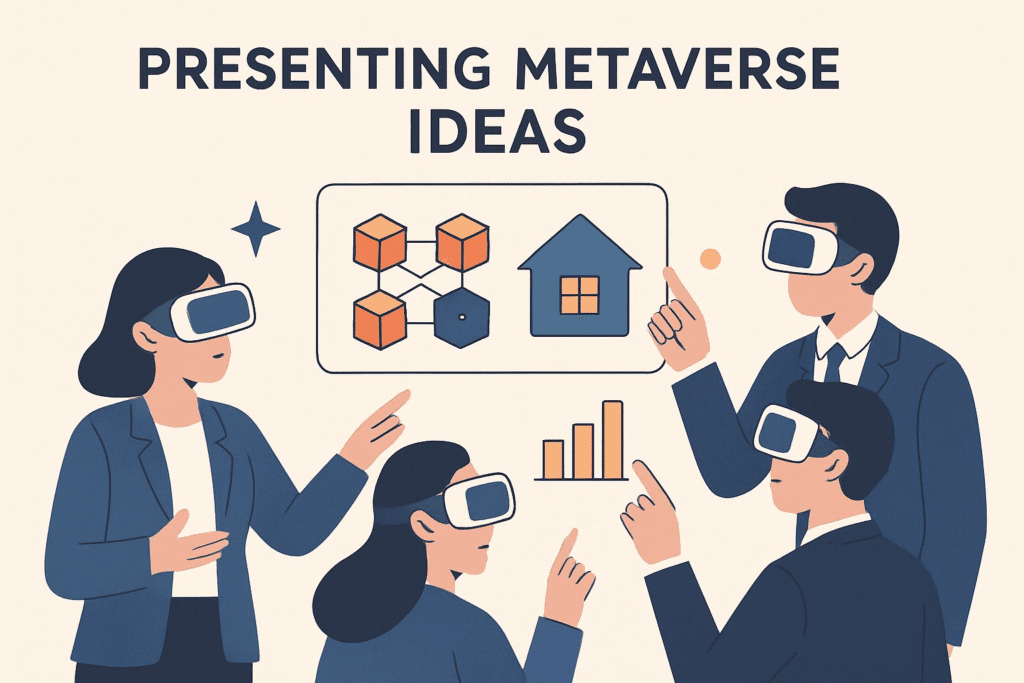The Rise and Retreat of the Metaverse: What Really Happened?

Just a few years ago, the term “metaverse” echoed across boardrooms, tech expos, and news headlines like the next industrial revolution. We were promised a digital universe where people could work, socialize, play, and even own land—all inside immersive virtual environments. Facebook even rebranded itself as Meta, signaling just how seriously Silicon Valley was betting on this bold vision. Investors poured in billions. Virtual real estate prices skyrocketed. Startups with pixelated avatars and lofty whitepapers were getting funded overnight.
And then—almost as quickly as it rose—it stumbled.
User numbers began to plateau. Virtual events felt more gimmicky than groundbreaking. Digital storefronts remained mostly empty. Today, the metaverse feels less like a utopian frontier and more like a deserted simulation. So what happened?
Was it a case of technological ambition outrunning human readiness? Were we sold a dream before the infrastructure—and real human demand—was there? Or did the narrative itself become too grand, too fast, for reality to catch up?
In this blog, we’re pulling back the curtain on the metaverse collapse—looking beyond the headlines to uncover:
- The hidden reasons why virtual worlds fell short
- What went wrong behind the scenes
- And whether immersive technology has a second act
Because while the metaverse as we knew it may be fading, the story of immersive digital experiences is far from over.
Let’s unpack the real lessons from the virtual world’s crash—and what comes next.
The Rise and Fall of the Metaverse: What Went Wrong?

Once positioned as the natural evolution of the internet, the metaverse promised a seismic shift in how we live, work, and connect online. The vision was bold: immersive digital spaces where users could attend virtual concerts, purchase virtual real estate, build decentralized economies, and even maintain digital identities. Major tech players like Meta, Microsoft, and Google threw their weight—and billions of dollars—behind the concept, anticipating a new era of online life that would redefine everything from gaming to global business.
But behind the futuristic trailers and ambitious roadmaps, cracks began to show. Despite its high-profile launch and media buzz, the metaverse failed to achieve mass adoption. Engagement levels fell, user retention proved elusive, and investor optimism gave way to hard financial realities.
The Early Optimism: Building a Digital Utopia
At its height, the metaverse wasn’t just a tech trend—it was seen as the future itself. The early momentum painted a picture of boundless opportunity:
- Massive capital injection: Meta alone invested over $46 billion into metaverse development, hoping to secure early dominance.
- Digital land rush: Virtual real estate became a speculative craze, with companies and individual investors spending millions to claim parcels in platforms like Decentraland and The Sandbox.
- Blockchain and NFTs: The integration of non-fungible tokens (NFTs) was expected to underpin entire virtual economies, where digital ownership was verifiable and tradeable.
- Corporate gold rush: Analysts projected the metaverse could become a $1 trillion industry, sparking a wave of brand activations—from virtual fashion shows to product launches in avatar-driven worlds.
During this phase, it felt like the internet was on the brink of its next great reinvention.
The Collapse: When Vision Outpaced Reality
However, it wasn’t long before the metaverse dream collided with real-world limitations. Despite the bold projections and headlines, several fundamental issues derailed momentum:
- Low user retention: Virtual platforms struggled to keep users engaged beyond the novelty phase. Daily active user numbers remained stagnant or declined, undermining long-term viability.
- Hardware adoption lag: Immersive experiences required VR headsets, but adoption remained slow—by 2022, only 18% of Americans owned one, and even fewer used them regularly.
- Mounting financial losses: Reality Labs, Meta’s metaverse division, reported a $3.73 billion loss in a single quarter, highlighting the widening gap between investment and returns.
- NFT market collapse: As hype faded, the trading volume for metaverse-linked NFTs dropped by over 80% in 2024, revealing a fragile economic model based more on speculation than utility.
In the end, the metaverse narrative suffered not from a lack of imagination—but from a misalignment between technological maturity, consumer behavior, and practical application.
Why the Metaverse Failed: The Five Core Cracks Beneath the Hype

Despite a storm of early enthusiasm, the metaverse failed to evolve into the mainstream phenomenon it was expected to become. While some still argue it was simply ahead of its time, the reality is more nuanced. Its collapse wasn’t caused by a single flaw, but by a convergence of technological, economic, and human-centered challenges. Below, we break down the five core reasons why the metaverse never lived up to its promise.
A. Lack of Meaningful User Engagement
At the heart of the metaverse’s failure was an inability to keep users coming back. Early adopters may have logged in to explore out of curiosity, but very few stayed. Why?
- Overcomplicated interfaces: Instead of being intuitive, many metaverse platforms felt like early-stage prototypes. For non-technical users, basic navigation became a chore.
- Steep learning curves: Interacting in a virtual world often required mastering unfamiliar mechanics, deterring casual users from sticking around.
- Shallow social experiences: Ironically, a technology meant to bring people together often felt isolating. Users found it hard to build meaningful connections or communities in the digital void.
Without compelling reasons to return—no engaging gameplay loops, no rewarding social systems—the novelty wore off fast.
B. Technological Immaturity and Infrastructure Gaps
While the idea of immersive, lifelike virtual worlds was seductive, the technology simply wasn’t ready to deliver the promised experience at scale.
- High hardware costs: Premium VR headsets remained prohibitively expensive for most consumers, limiting access and adoption.
- Visual fidelity issues: Many virtual environments looked dated or unconvincing, breaking immersion and undercutting the “realism” they were supposed to deliver.
- Latency and bandwidth bottlenecks: Smooth interaction is critical in immersive spaces. Unfortunately, lag, jittery visuals, and inconsistent connectivity shattered the illusion for many users.
Until VR and AR hardware becomes as accessible, portable, and seamless as smartphones, the metaverse remains a niche domain, not a mass-market solution.
C. An Unsustainable Economic Framework
The metaverse wasn’t just sold as a new form of social interaction—it was touted as a new kind of economy. But that economy was built on speculation rather than substance.
- Digital real estate bubbles: Millions were poured into virtual land, with little actual utility. When user interest dipped, so did the value—dramatically.
- NFT collapse: Touted as the building blocks of the virtual economy, NFT assets tied to metaverse platforms lost over 80% of their trading volume by 2024.
- No clear revenue models: Most businesses couldn’t generate predictable income. The platforms lacked native monetization systems that made sense for real-world entrepreneurs.
Instead of empowering creators and businesses, the metaverse ended up amplifying the volatility of digital speculation.
D. Privacy, Security, and Trust Deficits
Trust is non-negotiable in any digital ecosystem—especially one asking users to spend hours immersed and invest real money. The metaverse struggled to provide that sense of safety.
- Widespread data concerns: Users were wary of who controlled their data and how it would be used. With tech giants behind the scenes, fears of surveillance were hard to dismiss.
- Vulnerability to scams and fraud: From fake NFT marketplaces to phishing attacks in virtual storefronts, security lapses eroded confidence.
- Regulatory vacuum: With no clear legal framework, concepts like virtual ownership, digital identity, and intellectual property remained legally murky.
In the absence of digital rights and accountability, many users simply opted out.
E. Corporate-Centric Models That Missed the Point
Ironically, while the metaverse was framed as a decentralized utopia, the dominant platforms were anything but.
- Failed monetization schemes: Subscription-based models and overpriced digital goods felt more exploitative than empowering.
- Limited creative ecosystems: Users expected open, dynamic, and modifiable worlds—but got walled gardens with clunky tools and little freedom.
- Mediocre experiences: Flagship platforms like Meta’s Horizon Worlds suffered from poor design, awkward avatars, and minimal content, leading to widespread disappointment.
The lack of user-generated innovation—combined with corporate control—made the metaverse feel less like a revolution and more like an expensive experiment.
A Hard Lesson in Digital Overreach
The downfall of the metaverse teaches us a critical lesson: ambition without alignment leads to failure. You can’t simply throw money at a concept, dress it in buzzwords, and expect the world to follow. The technology has to work. The experience has to matter. And the people—above all—have to want it.
The dream of immersive digital interaction isn’t dead. But its first iteration was deeply flawed. The question now is: can the next wave of builders learn from these missteps?
What’s Next for Immersive Technology?

Beyond the Metaverse Hype, a More Grounded Digital Future Emerges
The fall of the metaverse isn’t the end of immersive technology—it’s the beginning of its recalibration. While the grand visions of avatar-filled cities and billion-dollar digital real estate fizzled, the core technologies behind those visions—virtual reality, augmented reality, spatial computing, and even brain-machine interfaces—have quietly continued to evolve.
Rather than aiming to replace the physical world, the next era of immersive tech is focused on enhancing it. The future will be less about escaping reality and more about augmenting it with intelligence, interactivity, and immersion—in ways that are practical, accessible, and deeply integrated into daily life.
A. Virtual Reality: From Gimmick to Utility
Virtual reality, once synonymous with gaming arcades and speculative ventures, is becoming more mature and purposeful. As hardware becomes more compact and affordable, its use cases are expanding far beyond entertainment.
- Gaming Redefined: Developers are moving past novelty toward deeply immersive, interactive storytelling. With lifelike physics, haptic feedback, and AI-driven NPCs, VR gaming is becoming an experience that rivals blockbuster cinema.
- Enterprise Adoption: Companies in healthcare, manufacturing, and defense are using VR for training simulations, reducing costs and improving safety. It’s being used to train surgeons, simulate high-risk environments, and model complex logistics.
- Better Accessibility: Entry-level headsets with wireless functionality and improved UX are breaking down barriers. Combined with 5G and edge computing, real-time collaboration in VR is finally becoming viable.
The next generation of VR will likely be AI-enhanced, cloud-powered, and functionally useful, not just fun.
B. Augmented Reality & Mixed Reality: Merging Digital with Physical
Unlike VR, which creates entirely virtual spaces, augmented reality (AR) and mixed reality (MR) are finding success by blending the digital and physical in meaningful ways. They don’t ask users to leave the real world—just to look at it differently.
- Retail & E-commerce: AR tools let users visualize furniture in their homes or try on clothes digitally, reducing returns and boosting confidence in purchases.
- Healthcare & Education: Surgeons can overlay diagnostic data in real time; students can interact with 3D anatomy models, changing how we learn and teach.
- Spatial Computing: Mixed reality devices are enabling “digital twins” of physical spaces—perfect replicas that can be analyzed, simulated, or modified virtually, transforming architecture, urban planning, and logistics.
AR’s power lies in contextual computing—digital content that adapts to your real-world environment, guided by AI and anchored in purpose.
C. Decentralized Digital Worlds: A Smarter Approach to Virtual Presence
Though the first generation of metaverse platforms floundered, a quieter movement is taking shape—built not by mega-corporations, but by decentralized communities and blockchain developers. These virtual environments aren’t chasing hype; they’re focused on utility, ownership, and sustainability.
- Utility-Focused NFTs: No more overpriced JPEGs—NFTs are now being designed with function in mind: access passes, verifiable credentials, and in-game assets with real use.
- Remote Collaboration Hubs: Instead of open-ended social worlds, developers are creating focused spaces for remote teams, design collaboration, and client engagement.
- Decentralized Economies: Using smart contracts, users can earn, trade, and build in ecosystems where they actually own their assets and identities.
This shift marks a move away from speculative bubbles and toward long-term digital infrastructure—where users are builders, not just consumers.
D. Brain-Computer Interfaces & the Spatial Web: The Edge of Innovation
At the frontier of immersive tech, we’re seeing developments that once belonged to science fiction. These aren’t just extensions of current platforms—they’re paradigm shifts in how humans and machines interact.
- Neural Interfaces: Brain-computer interaction is no longer a theoretical concept. Companies like Neuralink and CTRL-Labs are developing interfaces that can interpret neural signals, opening possibilities for thought-driven input.
- The Spatial Web (Web 3.0): Imagine a version of the internet that isn’t flat or scrollable, but spatial, immersive, and responsive. This next phase of the web will blend AI, AR, and 3D environments to deliver a persistent digital layer over the physical world.
- Immersive Intelligence: The convergence of AI and XR (extended reality) means smarter environments—your workspace could adapt to your habits, your car interface could respond to eye movement, your digital assistant might appear as a holographic avatar.
These innovations represent a future where interaction becomes intuition, and technology fades into the background of seamless experience.
Final Thoughts: From Vision to Viability
The metaverse may have collapsed under the weight of its own promises, but immersive technology is far from dead. In fact, it’s evolving—quietly, thoughtfully, and more aligned with human needs than ever before. The future won’t be a pixelated escape—it will be a smarter, more interactive world layered seamlessly over our existing one.
The winners in this next wave won’t be those who shout the loudest—but those who build the most useful, ethical, and human-centered immersive experiences.
Amazon Books Recommendation Section
For readers interested in exploring the metaverse’s rise, challenges, and future potential, these carefully selected books provide insightful perspectives from experts in the field:
1. The Metaverse: And How It Will Revolutionize Everything by Matthew Ball
Matthew Ball offers a comprehensive analysis of the metaverse’s underlying technologies, economics, and cultural impact. This book unpacks what makes the metaverse more than just a buzzword and explores how it could reshape industries and everyday life.
Find it on Amazon: Link
2. Why the Metaverse Matters: From Second Life to Meta & Beyond by Wagner James Au
Wagner James Au, a longtime observer of virtual worlds, delves into the promises and pitfalls of the metaverse phenomenon. His book traces the evolution from early virtual communities to today’s ambitious projects, providing critical insights on what the future might hold.
Find it on Amazon: Link
Conclusion
The rise and fall of the metaverse highlights a critical truth about emerging technologies: ambition alone isn’t enough. Despite promises of immersive digital universes, decentralized ownership, and limitless virtual possibilities, the first wave of metaverse platforms collapsed under the weight of inflated expectations and fragmented execution.
Core challenges ultimately derailed its momentum. Users didn’t find enough value to stay engaged. Hardware barriers like expensive VR headsets limited access. Economic models built on hype—such as NFT speculation and overpriced virtual land—proved unsustainable. Privacy concerns, platform security issues, and corporate centralization further eroded trust. In the end, many platforms failed to offer anything that felt more meaningful or useful than what already existed on the internet.
But this is not the end of immersive technology—it’s merely the end of its first, flawed chapter. The real transformation is only just beginning.
New developments in augmented and mixed reality are offering tools that seamlessly integrate with our physical world, not try to replace it. Brain-computer interfaces and spatial computing are pushing the boundaries of how we interact with digital content. These technologies are focused not on spectacle, but on function—solving real problems, enhancing productivity, and improving the quality of human-computer interaction.
The next era won’t be about escaping into pixelated fantasies—it will be about building digital layers that enrich our real lives. And instead of being driven by speculative bubbles, this wave will be grounded in utility, accessibility, and intelligent design.
If the metaverse was a prototype, then what comes next might just be the blueprint for a more thoughtful and truly immersive digital future.
FAQ’s
Why did the metaverse fail?
The metaverse faced multiple challenges, including low user engagement, technological barriers like expensive VR hardware, economic instability from speculative investments, privacy and security concerns, and business models that didn’t meet user expectations.
Was the metaverse just a tech bubble?
In many ways, yes. The metaverse went through a classic hype cycle: initial excitement fueled huge investments, but without widespread adoption or sustainable use cases, the bubble eventually burst.
What happened to Meta’s metaverse project?
Meta committed billions to its Horizon Worlds platform, but user participation remained limited. This led to significant financial losses and a strategic pivot toward artificial intelligence and other emerging technologies.
Will virtual worlds make a comeback?
While the early vision of the metaverse struggled, new technologies like augmented reality (AR), mixed reality (MR), and spatial computing are driving the evolution of immersive experiences that may find more practical and lasting applications.
What’s next for immersive technology?
The future includes AI-enhanced extended reality, decentralized virtual environments powered by blockchain, brain-computer interfaces, and advanced holographic displays—offering immersive experiences grounded in real-world utility rather than speculation.
